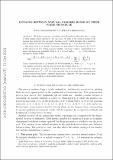Files in this item
Distance between natural numbers based on their prime signature
Item metadata
| dc.contributor.author | Kolossváry, István B. | |
| dc.contributor.author | Kolossváry, István T. | |
| dc.date.accessioned | 2023-01-25T00:38:16Z | |
| dc.date.available | 2023-01-25T00:38:16Z | |
| dc.date.issued | 2022-05 | |
| dc.identifier | 271862390 | |
| dc.identifier | f7140d5f-3938-445e-bab0-8b6e820a41f0 | |
| dc.identifier | 85118341682 | |
| dc.identifier | 000795908300006 | |
| dc.identifier.citation | Kolossváry , I B & Kolossváry , I T 2022 , ' Distance between natural numbers based on their prime signature ' , Journal of Number Theory , vol. 234 , pp. 120-139 . https://doi.org/10.1016/j.jnt.2021.09.010 | en |
| dc.identifier.issn | 0022-314X | |
| dc.identifier.other | ArXiv: http://arxiv.org/abs/2005.02027v2 | |
| dc.identifier.other | ORCID: /0000-0002-2216-305X/work/133736960 | |
| dc.identifier.uri | https://hdl.handle.net/10023/26824 | |
| dc.description | Funding: ITK was financially supported by a Leverhulme Trust Research Project Grant (RPG-2019-034). | en |
| dc.description.abstract | Each natural number is uniquely determined by its prime signature, an infinite dimensional vector indexed by the prime numbers in increasing order. We use this to define a new metric between natural numbers induced by the l∞ norm of the signatures. In this space, we look at the natural analog of the number line and, in particular, study the arithmetic function L∞(N), which tabulates the cumulative sum of distances between consecutive natural numbers up to N in this new metric. Our main result is to identify the positive and finite limit of the sequence L∞(N)/N as the expectation of a certain random variable. The main technical contribution is to show with elementary probability that for K=1, 2 or 3 and ω0,= ..., = ωK ≥ 2 the following asymptotic density holds lim n→ ∞ |{M ≤ n: ||M-j||∞ < ωj for j = 0, ..., K}|/n= π p:prime (1-KΣj=0 1/pωj) This is a generalization of the formula for k-free numbers, i.e. when ω0 = ... = ωK = k. The random variable is derived from the joint distribution when K = 1. As an application, we obtained a modified version of the prime number theorem. our computations up to N = 1012 have also revealed that prime gaps show a considerably richer structure than on the traditional number line. Moreover, we raise additional open problems, which could be of independent interest. | |
| dc.format.extent | 1910007 | |
| dc.language.iso | eng | |
| dc.relation.ispartof | Journal of Number Theory | en |
| dc.subject | Power-free numbers | en |
| dc.subject | Prime grid | en |
| dc.subject | Limiting densities | en |
| dc.subject | Distribution of primes | en |
| dc.subject | QA Mathematics | en |
| dc.subject | T-NDAS | en |
| dc.subject.lcc | QA | en |
| dc.title | Distance between natural numbers based on their prime signature | en |
| dc.type | Journal article | en |
| dc.contributor.sponsor | The Leverhulme Trust | en |
| dc.contributor.institution | University of St Andrews. Pure Mathematics | en |
| dc.identifier.doi | 10.1016/j.jnt.2021.09.010 | |
| dc.description.status | Peer reviewed | en |
| dc.date.embargoedUntil | 2023-01-25 | |
| dc.identifier.url | https://arxiv.org/abs/2005.02027 | en |
| dc.identifier.grantnumber | RPG-2019-034 | en |
This item appears in the following Collection(s)
Items in the St Andrews Research Repository are protected by copyright, with all rights reserved, unless otherwise indicated.

